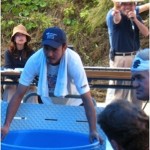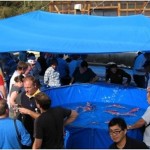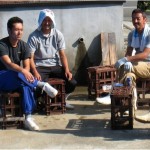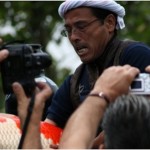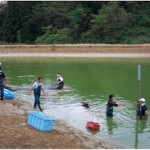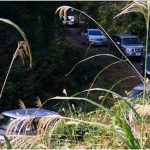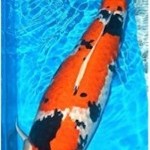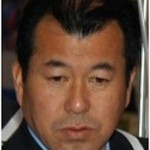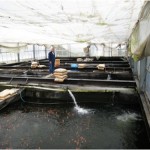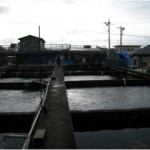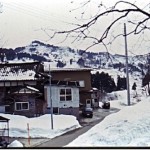Chapter Eighteen – THE LAST DANCE.
From 2000 onwards, Toshio’s mud pond harvests near Tochio became the place to be for overseas Koi enthusiasts especially those from the USA and the UK. His many visits to these countries had produced many more fans and he capitalised on this fact and decided to make his most important harvests also a good day out for his ever growing number of fans.

The narrow tracks leading up to the four main ponds were littered with hire cars abandoned wherever they could be just as long as the Koi transportation trucks could pass by.
The combined staff of Isawa Nishikigoi Center and Yamamatsu were the guys used together with many enthusiasts eager to lend a hand – but all under the watchful eyes of Toshio and Toshiyuki.

The Koi were taken to the trucks in vinyl bags as the cameras clicked merrily away and then deposited carefully into the bowls on the truck beds. The bowls are used to rinse the mud and debris from the Koi before being taken to the main transportation tank.

The brothers Sakai always carried out the task of lifting them from the bowl and into the oxygen container. Many of these special Koi were over 80cms and that’s when the clicks of expensive cameras really started to resound.


(Toshio had a fascination with cameras although I don’t recall seeing him with one. He could mimic perfectly the ‘ker-chuk’ of the high priced cameras and also the ‘tic’ of the cheaper ones.)
Generally the harvests commenced at 9.30am and by 12.30pm the trucks were loaded and the convoy headed back to Mushigame with their treasures aboard.
One by one the visitor’s vehicles followed on but it’s only after all the Koi are placed safely into the indoor ponds that these main guys can get a breather.

Left Toshiaki Sakai, Yamamatsu; centre Toshi Sakai, Isawa Nishikigoi Center and right Hiromi Igarashi, Toshio’s right hand man.
Soon after these earlier harvests and the return of the Koi to the Mushigame concrete ponds for viewing; Toshio added more spice to the day by way of an auction, which became a huge success with the fans.

Toshio is also an expert when it comes to auctioning Koi to Japanese buyers but not as hot with the overseas ones.

Thankfully his daughter Miwa and son Toshi can take care of all that today.
Today he extends the perfect day even further by holding an evening reception in Nagaoka for his guests, and of course, he is the perfect host.
(The shy individual I first met in 1982 would have run a mile rather than have to face a hundred fans at an evening bash!)
The once nervous and guarded personality is no more; as his pre-planned achievements came to fruition so too did his self-confidence.
He heeded the more popular questions put to him by his audiences and did his damndest to give his audiences what they wanted.
No doubt the ladies found him to be charming and cute so they didn’t have any objections to their husbands spending a little more than was planned with him.
Today he has an image to maintain, whilst working with his Koi he wears the clothes of a Koi breeder but when entertaining he’s turned out like a film star or an entertainer because that’s exactly what he is.
Whilst he may come out with his new words from time to time – ‘maruzome’; ‘atarashi’; ‘kamisori’ and the like for his fans, whilst I walk away to hide a chuckle; the serious side of Toshio is always there and as sharp as it ever was.
He was born, bred and grew up with Nishikigoi and not exactly in the lap of luxury, now add the fact that he knew he would not be in line for any inheritance. That cannot have been the happiest of situations for Toshio to face in his mid teens.
In 1965, Koi exploded throughout Japan when Toshio was around 19 years old and the reverberations must have sounded out through Yamakoshi – the only place they were available from in those days.
Kazuto first set up business in Mushigame in ’65 and Marusada was only set up in ’62.
How would a young Toshio have viewed what was going on all around him in those heady days as he watched substantial amounts of money coming into the family household for the very first time?
No question at all, it was money that motivated the young Toshio but more to the point it was the dread of being eternally poor that fired him up and he has often mentioned this in conversations.
Unlike myself, who let my life take me wherever it wished to take me, Toshio worked to advance plans that were very carefully considered before he actually started to work on them.
Producing an entirely new strain of Koi is not a thing that can be rushed and he knew only too well it would take him many years to complete – he also knew there would be a significant pot of gold at the end of it all if he succeeded.
In order to succeed he needed enthusiasm, determination and a significant amount of know-how; the know-how he needed was a deep understanding of Koi together with a genuine love for them.
Of course, growing up in Mushigame village wasn’t exactly ‘a disadvantage’ was it?
But what a decision to take single-handedly, by upping sticks and moving his life some 200-miles south into a noisy and bustling city that was built with concrete as opposed to the silence of the mountains – think about it.
What is in his head right now, I have no idea but you can bet there is something plotted!
Some of the most wonderful times in my life have been spent being associated with Toshio or spin-offs directly attributed to him and there are thousands of items, stories and snippets still untold.
As to the worth or the desirability of his very best stocks?
In 2002-3 some very serious Koi enthusiasts who had been coming to Japan with me on many previous trips suggested that on future trips they would join me in Isawa after exiting Narita airport, spend two days with Toshio and then head straight back home!
 The Isawa Nishikigoi Center is a ‘Koi farm’ in the truest sense of the word but please don’t assume Toshio has produced every Koi for sale at the farm because that would be a mistake. Toshio, like many other breeders with an ‘eye’, buys tategoi from many other breeders throughout Japan.
The Isawa Nishikigoi Center is a ‘Koi farm’ in the truest sense of the word but please don’t assume Toshio has produced every Koi for sale at the farm because that would be a mistake. Toshio, like many other breeders with an ‘eye’, buys tategoi from many other breeders throughout Japan.
Over the years there have been many Kohaku for sale he has purchased from SFF and many Showa purchased from Isa in Ojiya. At the same time many other breeders purchase many of Toshio’s tategoi.
Before closing this mini book, I’ll point out here that Waddy wasn’t at his best in 2004, some have offered that it was the after effects of the earthquake but that was not the case although it did throw me ten feet to the right and into a steel door whilst the computer and television smashed into the bedroom ceiling.
No, in truth it was the pressure that had worn me down and my chosen medicine to relieve the pressure – namely whisky – and lots of it!
That’s a simple and truthful explanation but there were far more complex matters behind it all.
The only reason I mention this is that in early October 2004 whilst at Isawa, Toshio asked me to come back the following April with a formal suit – something I didn’t own.
Apparently he’d discussed a matter with several Yamakoshi breeders and had tentatively reserved the main hall of the Yamakoshi Village Office where the mayor of Ojiya had agreed to attend to present me with some token of appreciation for ‘Mr. Peter’s Services’ in spreading the word of Nishikigoi to many countries outside of Japan and, in doing so, had brought significant added revenue into the City of Ojiya by way of taxes to the local government and also increased revenue to the breeders of Yamakoshi.
That was roughly the gist of it all and several breeders in Yamakoshi mentioned it to me with a wink and a smile.
I did say I would return the following April with a suit, shirt and tie but, at that particular time in my life, I knew I wouldn’t have been able to even handle the plane journey there.
The last time I saw Toshio was in November 2004 although I have spoken with him since. He walked into the Nomole bar late one evening looking a little worse for wear and no wonder.
That day he’d driven to Ojiya, bought a generator and tied it to his back before walking from the outskirts of Ojiya and straight over the mountains as the crow flies to rig it up in his indoor pond in Mushigame.
Many detours had to made around the devastation.
After that he had to walk all the way back!
Which goes to show – you can take the man out of Mushigame but you can’t take Mushigame out of the man!
Anyway that’s the major part of my experiences with all the wonderful people who go to make up the hallowed word ‘Matsunosuke’ – full circle.
On reflection, it’s strange to think it all started out on my back patio in 1979 with those RED red, BLACK black and WHITE white Koi and my determination to find out where they had been produced and who had produced them.
It’s true, I did find out where they came from – but I also found out more than I’d ever thought was possible from Toshio Sakai, the visionary and the constant challenger to the norm.
Thanks for all you have taught me Sir – about Koi AND life.
‘Hope you read this one day Toshio – hope I didn’t say anything really naughty did I?’

Mr. Peter.
















